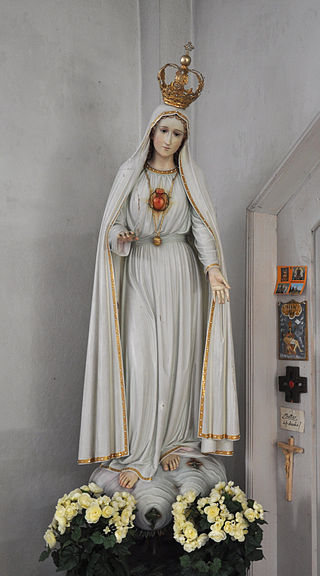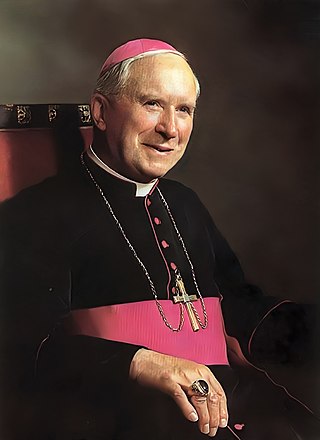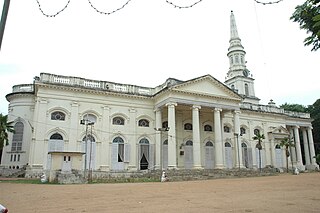
Chrism, also called myrrh, myron, holy anointing oil, and consecrated oil, is a consecrated oil used in the Catholic, Eastern Orthodox, Oriental Orthodox, Assyrian, Nordic Lutheran, Anglican, and Old Catholic churches in the administration of certain sacraments and ecclesiastical functions.

Consecration is the transfer of a person or a thing to the sacred sphere for a special purpose or service. The word consecration literally means "association with the sacred". Persons, places, or things can be consecrated, and the term is used in various ways by different groups. The origin of the word comes from the Latin stem consecrat, which means dedicated, devoted, and sacred. A synonym for consecration is sanctification; its antonym is desecration.
Ex opere operato is a Latin phrase meaning "from the work worked" that, in reference to sacraments, signifies that they derive their efficacy not from the minister or from the recipient, but from the sacrament considered independently of the merits of the minister or the recipient. According to the ex opere operato interpretation of the sacraments, any positive effect comes not from any human worthiness or faith, but from the sacrament as an instrument of God.

The Immaculate Heart of Mary is a Catholic devotion which refers to the view of the interior life of Mary, her joys and sorrows, her virtues and hidden perfections, and, above all, her virginal love for God the Father, her maternal love for her son Jesus Christ, and her motherly and compassionate love for all mankind. Traditionally, the Immaculate Heart is depicted pierced with seven swords or wounds, in homage to the seven dolors of Mary and roses, usually red or white, wrapped around the heart.

The consecration of Russia to the Immaculate Heart of Mary by a reigning pope was requested during a Marian apparition by Our Lady of Fátima on 13 July 1917, according to Lúcia dos Santos, one of the three visionaries who claimed to have seen the apparition. Sister Lucia said that at different times the Blessed Virgin Mary had given her a message of promise that the consecration of Russia to the Immaculate Heart of Mary would usher in a period of world peace.

In the Catholic Church, a consecrated virgin is a virgin woman who has been consecrated by the church as a bride of Christ. Consecrated virgins are consecrated by the diocesan bishop according to the approved liturgical rite, are required to maintain perpetual virginity because they are espoused to Christ, and are dedicated to the service of the Church.

The Diocese of Canberra and Goulburn is one of the 23 dioceses of the Anglican Church of Australia. The diocese has 60 parishes covering most of south-east New South Wales, the eastern Riverina and the Australian Capital Territory (ACT). It stretches from Marulan in the north, from Batemans Bay to Eden on the south coast across to Holbrook in the south-west, north to Wagga Wagga, Temora, Young and Goulburn.

The Écône consecrations were Catholic episcopal consecrations in Écône, Switzerland, on 30 June 1988 performed by Archbishop Marcel Lefebvre and Bishop Antônio de Castro Mayer. The bishops consecrated were four priests of Lefebvre's Society of Saint Pius X (SSPX). The consecrations, performed against the explicit orders of Pope John Paul II, represented a milestone in the troubled relationship of Lefebvre and the SSPX with the Church leadership. The Holy See's Congregation for Bishops issued a decree signed by its Prefect Cardinal Bernardin Gantin declaring that Lefebvre and De Castro Mayer had incurred automatic excommunication by consecrating the bishops without papal consent, thus putting himself and his followers in schism.
A consecrator is a bishop who ordains someone to the episcopacy. A co-consecrator is someone who assists the consecrator bishop in the act of ordaining a new bishop.

In Christianity, concelebration is the presiding of a number of presbyters at the celebration of the Eucharist with either a presbyter, bishop, or archbishop as the principal celebrant and the other presbyters and (arch)bishops present in the chancel assisting in the consecration of the Eucharist. The concelebrants assist the principal celebrant by reciting the Words of Consecration together with them, thus effecting the change of the eucharistic elements. They may also recite portions of the Eucharistic Prayer.
The Bishop of Bolton is an episcopal title used by a suffragan bishop of the Church of England Diocese of Manchester, in the province of York, England. The title takes its name after the town of Bolton in Greater Manchester; the See was erected under the Suffragans Nomination Act 1888, by Order in Council dated 8 February 1984.

Pope Pius XII consecration of the world to the Immaculate Heart of Mary took place on October 31, 1942. Pope Pius XII performed a Marian consecration, entrusting the world to the Virgin Mary, as Queen of Peace, through her Immaculate Heart.
Consecrations in Eastern Christianity can refer to either the Sacred Mystery (Sacrament) of Cheirotonea of a bishop, or the sanctification and solemn dedication of a church building. It can also be used to describe the change of the bread and wine into the Body and Blood of Christ at the Divine Liturgy. The Chrism used at Chrismation and the Antimension placed on the Holy Table are also said to be consecrated.

Consecration crosses are crosses on the interior walls and exterior architecture of a Christian church or cathedral showing where the bishop has anointed the church with chrism or holy water in order to consecrate it. There is often a place for a candle in front of each cross which is lit on the anniversary of the consecration. The crosses signify the sanctity of the church. The 13th-century Trinity Chapel in Salisbury Cathedral contains a painted consecration cross dating from 30 September 1225.

The consecration and entrustment to the Virgin Mary is a personal or collective act of Marian devotion among Catholics, with the Latin terms oblatio, servitus, commendatio and dedicatio being used in this context. Consecration is an act by which a person is dedicated to a sacred service, or an act which separates an object, location or region from a common and profane mode to one for sacred use. The Congregation for Divine Worship and the Discipline of the Sacraments clarifies that in this context, "It should be recalled, however, that the term "consecration" is used here in a broad and non-technical sense: the expression is use of 'consecrating children to Our Lady', by which is intended placing children under her protection and asking her maternal blessing for them".

Thomas Rattray (1684–1743) was a Scottish Episcopal bishop who served as the Primus of the Scottish Episcopal Church from 1738 to 1743.

The Diocese of Madras is a diocese of Church of South India in Tamil Nadu state of India.The diocese is one among the 22 dioceses of Church of South India, a United Protestant denomination.
Charles Rose was an Episcopalian clergyman who served in the Scottish Episcopal Church as the Bishop of Dunblane (1774–1791) and Bishop of Dunkeld (1776–1786).
Matthew John Parker is a British bishop who has served as area Bishop of Stafford since 2021. He was previously Archdeacon of Stoke since 2013.












